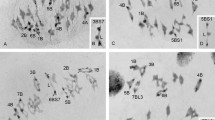Summary
The two arms of a bivalent can be bound (contain at least one chiasma) or not-bound (contain no chiasma). Formulae are presented to test the randomness of distribution of the bound arms over the chromosome complement, under the assumption that the probability of being bound is related to the arm length.
Testing meiotic configurations in Secale cereale (rye), Crotalaria intermedia and several species of Coffea, non-randomness was found in all cases, resulting in an excess of bivalents with only one arm bound. The effect is slightly different in the different plants. The basis is considered to be localization of chiasmata.
In rye plants, homozygous for a rather large translocation, an excess of univalents was observed to more than compensate the localization effect. This is attributed to the limited probability of the newly formed short arm of the small translocation chromosome to be bound.
Similar content being viewed by others
Literature
Bouharmont, J.: Recherches sur les affinités chromosomiques dans le genre Coffea. Publ. I.N.E.A.C., Sér. Sci. 77, 94p. (1959).
Gaul, H.: Asynapsis und ihre Bedeutung für die Genomanalyse. Z. indukt. Abstamm.-u. Vererb.-Lehre 86, 69–100 (1954).
Harte, C.: Untersuchungen über die Variabilität der Chiasmenbildung bei Paeonia tenuifolia. Chromosoma (Berl.) 8, 152–182 (1956).
Leliveld, J. A.: Nieuwe gezichtspunten voor het selectieonderzoek bij soortskruisingen van koffie naar aanleiding van cytologische gegevens. Bergcultures 14, (12), 370–386 (1940).
Mather, K., and R. Lamm: The negative correlation of chiasma frequencies. Hereditas (Lund) 20, 65–70 (1935).
Medina, D. M.: Observações citológicas em Coffea XIX. Microsporogênese em Coffea dewevrei. Bragantia 12, 153–162 (1952).
Mendes, C. H. T.: Observações citológicas em Coffea XVI. Microsporogênese em Coffea canephora Pierre ex Froehner. Bragantia 10, 97–104 (1950).
Müntzing, A., and S. Akdik: Cytological disturbances in the first inbred generations of rye. Hereditas (Lund) 34, 485–509 (1948).
Prakken, R.: Studies of asynapsis in rye. Hereditas (Lund) 29, 473–495 (1943).
Rees, H.: Genotypic control of chromosome behaviour in rye. I. Inbred lines. Heredity 9, 93–116 (1955).
Sybenga, J.: Inbreeding effects in rye. Z. Vererb.-Lehre 89, 338–354 (1958).
—: Some sources of error in the determination of chromosome length. Chromosoma (Berl.) 10, 335–364 (1959).
- Genetics and cytology of coffee. Bibliogr. genet. 1960 (in press).
Author information
Authors and Affiliations
Additional information
The section on rye was started at the Laboratory of Genetics, director Prof. Dr. R. Prakken, Agricultural University, Wageningen, Netherlands. It was completed, with the addition of the sections on Crotalaria and coffee, at the Inter-American Institute of Agricultural Sciences, Turrialba, C. R.
Cytogeneticist, Nuclear Energy Program, Inter-American Institute of Agricultural Sciences, Turrialba, Costa Rica, AEC Contract AT (30-1) 2043.
Rights and permissions
About this article
Cite this article
Sybenga, J. Non-random distribution of chiasmata in rye, Crotalaria and coffee. Chromosoma 11, 441–455 (1960). https://doi.org/10.1007/BF00328666
Received:
Issue Date:
DOI: https://doi.org/10.1007/BF00328666




